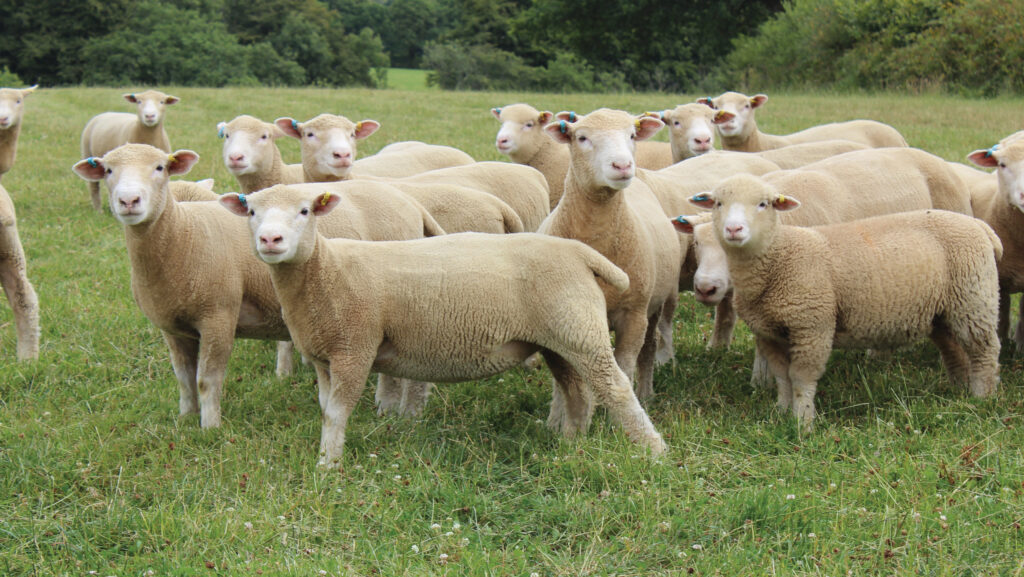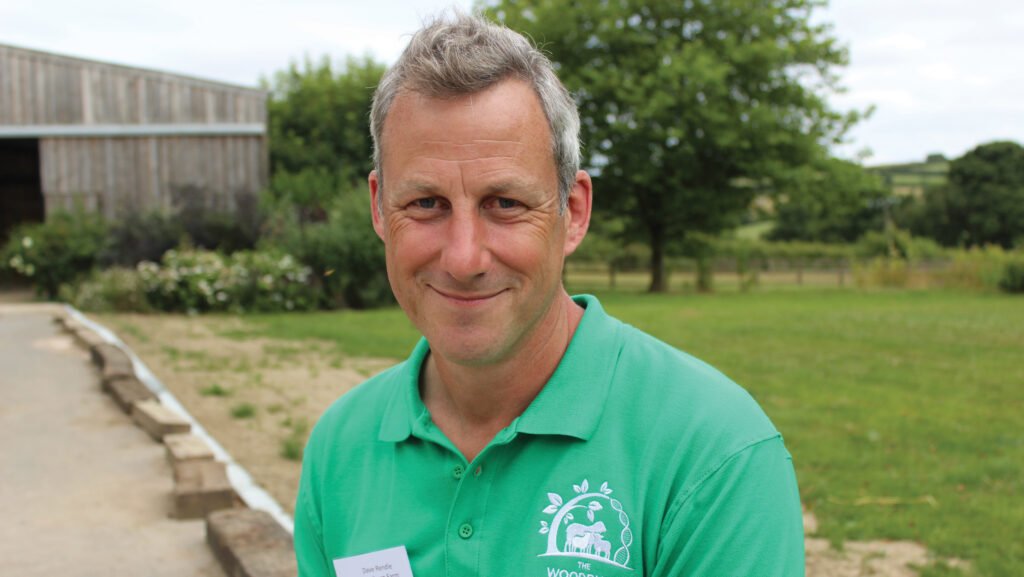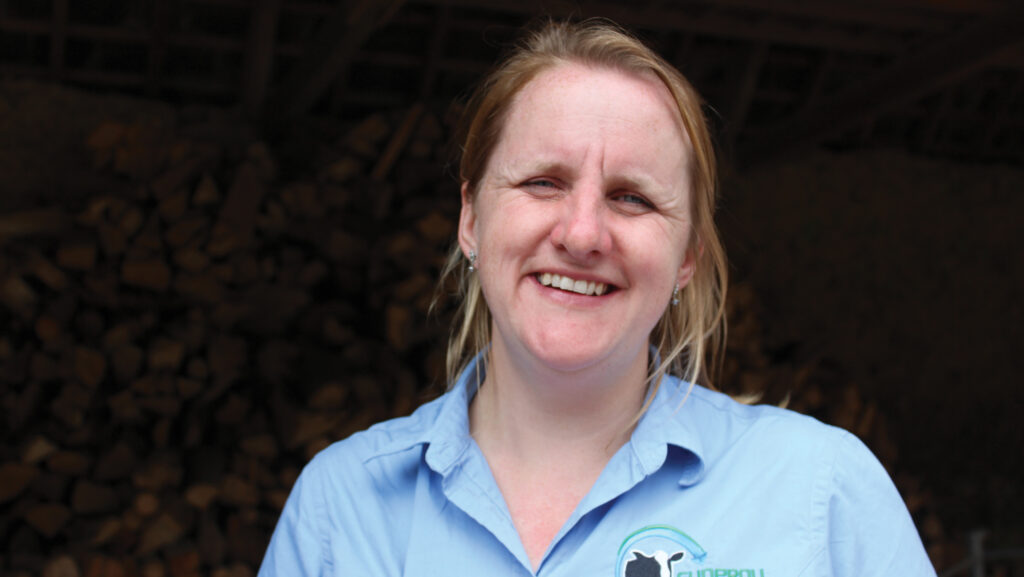Benefits of breeding values in lamb weights and ewe fertility
 © Ann Hardy
© Ann Hardy The only way of understanding the breeding potential of sheep is to use estimated breeding values (EBVs).
However, they should always be used alongside traditional visual assessment to indicate functionality and fitness.
This message, from Devon-based Poll Dorset producer Dave Rendle, came through from every speaker at an open day on Woodburn Farm near Tiverton, where Dave is driving up flock performance through genetics, with a particular focus on maternal traits.
“I select on estimated breeding values before I even look at the sheep. Other people often do it the other way around,” he said.
See also: 5 tips on lifting flock fertility this autumn
This policy has increased his flock average maternal index to 220.
This, in turn, has contributed to an increase in the average eight-week weights in lambs from less than 20kg in 2023, to 24kg in 2025.
There have also been substantial gains in maternal fertility, including a barren rate of just 3.51% across the flock’s 114 shearlings, while the number of lambs in in-lamb ewes averaged 178.4% across all age groups and 186.7% in ewe lambs in the 250-head flock.
These maternal performance figures were said by the farm’s vet, Emily Gascoigne from Synergy Farm Health, to be particularly strong for a flock that lambs out-of-season in September.
“This barren rate in shearlings is as good as in any flock, whether breeding in or out of season,” she added.
Flock establishment
Dave set up his flock four years ago, choosing the Dorset breed for its commercial traits, mothering ability and flexibility to breed out of season.
As an equine vet only shepherding part-time, this allowed him to lamb around other commitments.
He started by purchasing performance-recorded ewe lambs from the Sherborne, Blackhill and Prospect flocks, then sold 50 of the lowest index ewes after their first lambing.
Farm facts
Woodburn Farm, Tiverton, Devon
- 81ha of grassland and GS4 herbal leys on edge of Exmoor
- Up to 267m above sea level
- 250-head MV-accredited flock of Poll Dorset ewes
- Numbers increasing to 300-350 next year from retention of ewe lambs
- 12 stock rams
- September lambing
- 150 ewe lambs and 20 ram lambs retained or sold for breeding
- Ram lambs sold for breeding as shearlings privately, or through Centurion sale
- Other lambs finished from late December, sold direct to abattoir on early Dorset lamb contract
This sale, plus the acquisition of high-index stock from Gwenffrwd, saw the Woodburn flock take a step up in genetics and performance.
“I already had the performance-recording bug by then,” he recalled.
Also admitting to enjoying the data, he said: “I am convinced it has paid off.
“Data drives our management as well as our breeding decisions – it is instrumental to profitability.”
In future, Dave said that genotyping would also be used to improve genetic selection.
In contrast, he found the subjectivity around phenotype to be “frustrating”.

Dave Rendle © Ann Hardy
“Most of the things you look at when buying sheep are proxies for what you want in the carcass.
“Why look at a proxy when you can just look at the data for the trait itself?”
Even backfat scans were said to be proxies for carcass data, which was now readily available.
However, he acknowledged that good conformation (particularly feet) alongside other health and welfare traits was essential.
Now selling male and female stock, few ewe lambs go for slaughter, with many retained for breeding as the flock’s best genetics.
“I find it staggering when buyers don’t come and talk to me, or even look at a ram or its data before buying.
“We have all the data at our disposal, but they so often buy on a whim at the ringside.”
Remarking that different rams were bred for different purposes, he added: “You don’t pay any more for performance-recorded animals – sometimes less.”
Group performance
Dave said that he valued being part of Centurion Dorset Breeders – a group of like-minded, performance-recording producers credited for contributing to the breed’s improvement.
Sam Boon, manager of Signet Breeding Services, demonstrated the group’s influence using data that showed how the Dorset breed had made substantial genetic improvement since the 1990s.
Sam said maternal traits were invisible when buying a ram, and added that he was less interested in “whether a ram is a twin, than whether the pedigree behind it is littered with singles. EBVs do that thinking for you”.
Furthermore, he said that EBVs teased out environmental and management influences on an animal’s performance and specifically identified attributes that were due to genetics.
There are now more than 50 individual traits, with some recent additions.
“Ultrasound muscle depth has been used for years as a proxy.
“But now we also have abattoir data, which is useful in identifying traits farmers are actually paid for, and has led to a reduction in days to slaughter of about a week in the Dorset breed.”

Sam Boon © Ann Hardy
Another relatively new trait was resilience to gastrointestinal parasites.
This was proving to be more heritable than many health traits, offering promise for its genetic improvement.
The ewe’s immune response to worms was also being measured alongside genotypes, methane emissions and other traits in an Innovate UK-funded project, Breed for CH4nge, which reports in 2026.
This will help in the development of genomic indexes in the Dorset breed and further speed genetic improvement, particularly through the development of a breeding index for efficiency thereby reducing the ewe’s environmental impact.
Do not be daunted by data
Consultant sheep vet Emily Gascoigne urged every producer to performance record and said all flocks would have some essential, or basic, data that could be used.
This could be as simple as the movement book or scanning card.

Emily Gascoigne © Ann Hardy
“You can do a lot with these: the movement book telling you when lambs were finished and the scanning card about empties, singles, twins and triplets,” she said.
The processes could be simple and need not be daunting or involve expensive software.
Eight-week weights were also identified as among the most important to monitor as they gave a good indication of a ewe’s mothering ability and were, therefore, particularly useful for feeding into estimated breeding value data.
“Share the weights with your vet. Farmers often collect a lot of data, but may not think of sharing it with their vet.
“Real-time data can be really helpful for making management changes.”
Emily said to resist the temptation to try to address the whole production year in one hour, remarking that data from the Woodburn flock was reviewed and discussed every quarter.
“There are big gains to be made and you don’t have to save many lambs at £150 to cover the cost.
If you can see the value of performance recording, but don’t have the infrastructure or resources to do it yourself, at least buy a performance-recorded ram as 50% of the work is done for you.”
